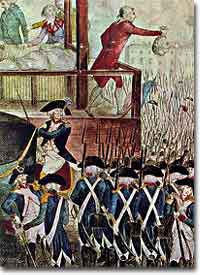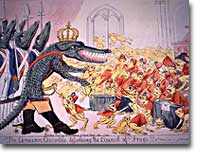71 TransAtlantic Crisis: The French Revolution

The violent uprising that was the French Revolution claimed the lives of many, including the spokesmen and leaders of all interests. Here, the head of King Louis XVI is displayed to an approving crowd.
The French Revolution brought fundamental changes to the feudal order of monarchical and aristocratic privilege. Americans widely celebrated the French Revolution in its glorious opening in 1789, as it struck at the very heart of ABSOLUTIST POWER. France seemed to be following the American republican example by creating a constitutional monarchy where traditional elites would be restrained by written law. Where the king had previously held absolute power, now he would have to act within clear legal boundaries.
The FRENCH REVOLUTION soon moved beyond this already considerable assault on the traditional order. Largely pushed forward by a crisis brought on by a war that began in 1792 against Prussia and Austria, the French Revolution took a dramatic turn that climaxed with the beheading of KING LOUIS XVI and the abandonment of Christianity in favor of a new state religion based on reason. The French Revolution became far more radical than the American Revolution. In addition to a period of extreme public violence, which became known as the REIGN OF TERROR, the French Revolution also attempted to enhance the rights and power of poor people and women. In fact, it even went so far as to outlaw slavery in the FRENCH COLONIES of the Caribbean.
The profound changes set in motion by the French Revolution had an enormous impact in France as well as through the large scale European war it sparked from 1792 to 1815. It also helped to transform American politics starting in the mid-1790s. While the French Revolution had initially received broad support in the United States, its radicalization in 1792-1793 led to sharp disagreement in American opinion.

This cartoon, “Corsican Crocodile dissolving the Council of Frogs,” depicts Napoleon’s coup d’état of the French government in 1799. Five years later he proclaimed himself Emperor of France.
Domestic attitudes toward the proper future of the American republic grew even more intense as a result of the example of revolutionary France. Conservatives like Hamilton, Washington, and others who would soon organize as the Federalist political party saw the French Revolution as an example of homicidal anarchy. When Great Britain joined European allies in the war against France in 1793, Federalists supported this action as an attempt to enforce proper order.
The opposing American view, held by men like Jefferson and others who came to organize as the Democratic-Republican political party, supported French actions as an extension of a world-wide republican struggle against corrupt monarchy and aristocratic privilege. For example, some groups among the Whiskey Rebels in western Pennsylvania demonstrated their international vision when they rallied beneath a banner that copied the radical French slogan of “LIBERTY, EQUALITY, AND FRATERNITY.”
The example of the French Revolution helped convince Americans on both sides that their political opponents were motivated by dangerous and even evil forces that threatened to destroy the young republic.

